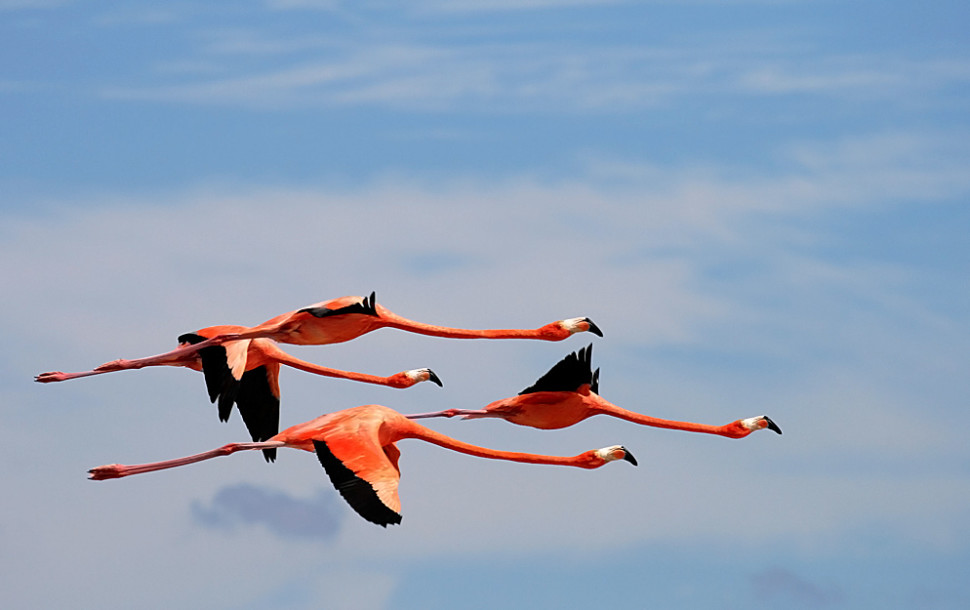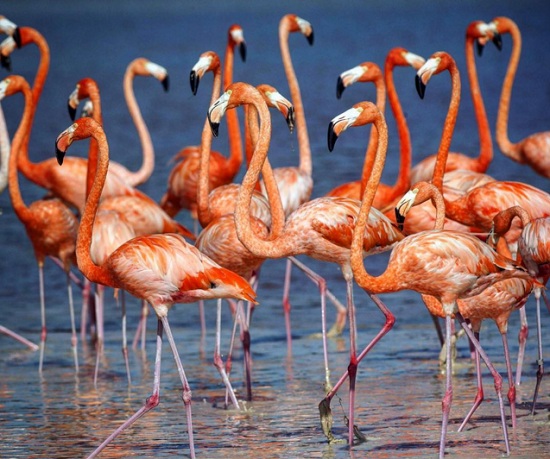The name Flamingo comes from Spanish flamenco, “as in the colour of flame”.
Flamingos often stand on one leg, the other leg tucked beneath the body. The reason for this behaviour is not fully understood. Recent research indicates that standing on one leg may allow the birds to conserve more body heat, given that they spend a significant amount of time wading in cold water.
However, the behaviour also takes place in warm water. As well as standing in the water, flamingos may stamp their webbed feet in the mud to stir up food from the bottom.
Flamingos like to wade in shallow saline waters in large groups of sometimes hundreds or thousands of birds. In the Yucatan Peninsula because counts are simply much lower, between 18,000 – 26,000 birds overall. But it´s obvious that flamingo birds do not value privacy.
Where to find them
In the state of Yucatan, flamingos are best observed at either Celestún (an hour and a half drive from Mérida) or at Río Lagartos (named after the many alligators the Spaniards found there when they started exploring the area, “largarto” is spanish for “gator”).
To get to Río Lagartos, take the tollway to Valladolid and from there go up north. You’ll pass the town of Tizimin (well-known because of the quality of its carpenters), to arrive on the north coast where you can hire a ‘lancha’ or small boat. There are also organized tours to both places.
Roundtrips to Celestún because it´s so easily accessible from Mérida. Tours from Cancun to Río Largartos are generally combined with a visit to the ruins of Ek Balam where you can climb the 30m high Acropolis and admire the almost completely conserved frieze on one of the terraces.
![]() When is the best time to see flamingos?
When is the best time to see flamingos?
Flamingo birds are best observed between December and April. During the rainy season there are sometimes very few birds, or none at all. Or sometimes you just can get lucky and see a flock or two.
So this doesn’t mean you should only go there in dry season. Celestun is beautiful even without flamingos. You can see many other bird species as well, like cormorants, the american stork, pelicans, spoonbills, ibis and, the cute little martín pescador. You might even run into an odd boa constrictor or small mammals like coatimundis (tejon) and raccoons. There are also two types of crocodiles endemic to the region, so be careful if you decide to take a dip in the lagoon.

Thousands of flamingos nest in the Ria Lagartos Biosphere Reserve in the state of Yucatán, one of the natural wonders of the Maya World and Mexico. (Photo: yucatan.travel)
Are flamingo birds naturally pink?
No they’re not. It comes with diet. The flamingo birds’ nesting season is also the rainy season. That’s when sometimes the water level is just too high and the flamingo runs out of leg, so to speak.
From Celestun they move up north to the more inaccessible salt lakes and beaches, where they build cones of sand that look like small volcanos. In the depression on top they deposit one egg (rarely two). When the chick hatches it has a greyish color and a straight bill.

These regal birds travel great distances, fanning out along the shoreline during the day in search of food and returning to roost in the reserve as dusk falls. (Photo: yucatan.travel)
The bill starts to bend within the week, but the pink color that gives the flamingo such high postcard value developes when they grow up. At the age of about three years they will have their vermillion color. Flamingos eat brine shrimp, algae and tiny crustaceans called Artemia which they sieve from the mud. This food contains high levels of beta carotene, and consequently the higher the level, the more pink they become.
After your boatride, go to the nearby village. It´s not too touristy and it features a nice beach and a couple of decent little restaurants where you can eat excellent seafood for just a few pesos.

Rio Lagartos was named biosphere reserve in 1979 to protect its incredible biodiversity: with 365 recorded bird species. (Photo: yucatan.travel)
For centuries, the American flamingo was hunted for food and its striking plumage, and captured by collectors for aviaries and zoos.
Bernal Diaz del Castillo, the soldier who wrote an eyewitness account of Hernan Cortes’ campaign to conquer Mexico in 1519-1521, reported seeing flamingos in the Aztec capital Tenochtitlan where they were kept in an aviary for Emperor Moctezuma’s pleasure. Nowadays, habitat destruction, the draining of wetlands and pollution have caused a decline in flamingo numbers throughout the Caribbean, placing the bird on the endangered species list.
The Yucatán flamingo population is also under threat. It rallied from a low of 5,000 birds in 1956 to 30,000 in 2002 and although more recent estimates put it at over 40,000, much remains to be done in the fight to save them.
In recent years, Mérida-based universities, research centers and conservation groups such as Niños y Crias, Pronatura and CAPY have been working with the inhabitants of Rio Lagartos on a variety of projects ranging from reforestation, conservation of key areas, efficient land management, flamingo, turtle and jaguar research and protection, environmental education and sustainable development.
Sources:





